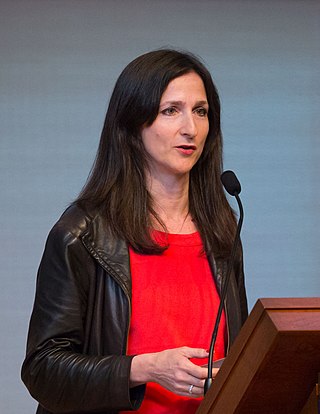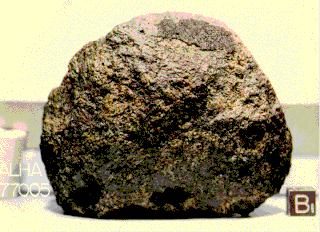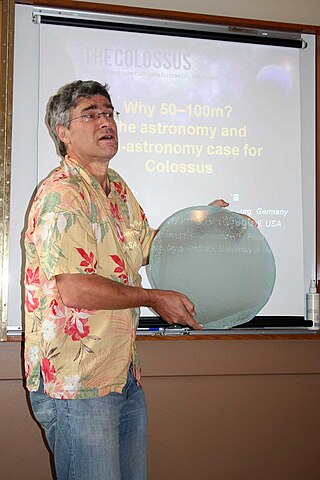
Astrobiology is a scientific field within the life and environmental sciences that studies the origins, early evolution, distribution, and future of life in the universe by investigating its deterministic conditions and contingent events. As a discipline, astrobiology is founded on the premise that life may exist beyond Earth.
Darwin was a suggested ESA Cornerstone mission which would have involved a constellation of four to nine spacecraft designed to directly detect Earth-like planets orbiting nearby stars and search for evidence of life on these planets. The most recent design envisaged three free-flying space telescopes, each three to four metres in diameter, flying in formation as an astronomical interferometer. These telescopes were to redirect light from distant stars and planets to a fourth spacecraft, which would have contained the beam combiner, spectrometers, and cameras for the interferometer array, and which would have also acted as a communications hub. There was also an earlier design, called the "Robin Laurance configuration," which included six 1.5 metre telescopes, a beam combiner spacecraft, and a separate power and communications spacecraft.
A biosignature is any substance – such as an element, isotope, molecule, or phenomenon that provides scientific evidence of past or present life. Measurable attributes of life include its complex physical or chemical structures, its use of free energy, and the production of biomass and wastes. A biosignature can provide evidence for living organisms outside the Earth and can be directly or indirectly detected by searching for their unique byproducts.

Polarimetry is the measurement and interpretation of the polarization of transverse waves, most notably electromagnetic waves, such as radio or light waves. Typically polarimetry is done on electromagnetic waves that have traveled through or have been reflected, refracted or diffracted by some material in order to characterize that object.

The Astrobiology Field Laboratory (AFL) was a proposed NASA rover that would have conducted a search for life on Mars. This proposed mission, which was not funded, would have landed a rover on Mars in 2016 and explore a site for habitat. Examples of such sites are an active or extinct hydrothermal deposit, a dry lake or a specific polar site.

Astrobotany is an applied sub-discipline of botany that is the study of plants in space environments. It is a branch of astrobiology and botany.

Sara Seager is a Canadian–American astronomer and planetary scientist. She is a professor at the Massachusetts Institute of Technology and is known for her work on extrasolar planets and their atmospheres. She is the author of two textbooks on these topics, and has been recognized for her research by Popular Science, Discover Magazine, Nature, and TIME Magazine. Seager was awarded a MacArthur Fellowship in 2013 citing her theoretical work on detecting chemical signatures on exoplanet atmospheres and developing low-cost space observatories to observe planetary transits.

51 Pegasi b, officially named Dimidium, is an extrasolar planet approximately 50 light-years away in the constellation of Pegasus. It was the first exoplanet to be discovered orbiting a main-sequence star, the Sun-like 51 Pegasi, and marked a breakthrough in astronomical research. It is the prototype for a class of planets called hot Jupiters.

The possibility of life on Venus is a subject of interest in astrobiology due to Venus's proximity and similarities to Earth. To date, no definitive evidence has been found of past or present life there. In the early 1960s, studies conducted via spacecraft demonstrated that the current Venusian environment is extreme compared to Earth's. Studies continue to question whether life could have existed on the planet's surface before a runaway greenhouse effect took hold, and whether a relict biosphere could persist high in the modern Venusian atmosphere.

Icebreaker Life is a Mars lander mission concept proposed to NASA's Discovery Program. The mission involves a stationary lander that would be a near copy of the successful 2008 Phoenix and InSight spacecraft, but would carry an astrobiology scientific payload, including a drill to sample ice-cemented ground in the northern plains to conduct a search for biosignatures of current or past life on Mars.
The Virtual Planetary Laboratory (VPL) is a virtual institute based at the University of Washington that studies how to detect exoplanetary habitability and their potential biosignatures. First formed in 2001, the VPL is part of the NASA Astrobiology Institute (NAI) and connects more than fifty researchers at twenty institutions together in an interdisciplinary effort. VPL is also part of the Nexus for Exoplanet System Science (NExSS) network, with principal investigator Victoria Meadows leading the NExSS VPL team.
The Carl Sagan Institute: Pale Blue Dot and Beyond was founded in 2014 at Cornell University in Ithaca, New York to further the search for habitable planets and moons in and outside the Solar System. It is focused on the characterization of exoplanets and the instruments to search for signs of life in the universe. The founder and current director of the institute is astronomer Lisa Kaltenegger.
The Mars Organic Molecule Analyser (MOMA) is a mass spectrometer-based instrument on board the Rosalind Franklin rover to be launched in 2028 to Mars on an astrobiology mission. It will search for organic compounds in the collected soil samples. By characterizing the molecular structures of detected organics, MOMA can provide insights into potential molecular biosignatures. MOMA will be able to detect organic molecules at concentrations as low as 10 parts-per-billion by weight (ppbw). MOMA examines solid crushed samples exclusively; it does not perform atmospheric analyses.

HD 36112, also known as MWC 758, is a young Herbig Ae star located in the constellation Taurus, surrounded by irregular rings of cosmic dust. The system is about 3.5 million years old. The disk has a cavity at 50 astronomical units and two spiral arms at 30-75 au that are seen in near-infrared scattered light, but only one spiral arm is seen in ALMA images.

The Center for Life Detection (CLD) is a collaboration among scientists and technologists from NASA’s Ames Research Center and Goddard Spaceflight Center, which formed in 2018 to support the planning and implementation of missions that will seek evidence of life beyond Earth. CLD is supported by NASA’s Planetary Science Division and is one of three core teams in the Network for Life Detection. CLD’s perspectives on life detection science and technology development are summarized in “Groundwork for Life Detection”, a white paper submitted to and cited in the 2023-2032 Planetary Science and Astrobiology Decadal Survey.

Allan Hills 77005 is a Martian meteorite that was found in the Allan Hills of Antarctica in 1977 by a Japanese National Institute of Polar Research mission team and ANSMET. Like other members of the group of SNCs, ALH-77005 is thought to be from Mars.
Large Interferometer For Exoplanets (LIFE) is a project started in 2017 to develop the science, technology and a roadmap for a space mission to detect and characterize the atmospheres of dozens of warm, terrestrial extrasolar planets. The current plan is for a nulling interferometer operating in the mid-infrared.

There are several methods currently used by astronomers to detect distant exoplanets from Earth. Theoretically, some of these methods can be used to detect Earth as an exoplanet from distant star systems.

Assembly theory is a hypothesis that characterizes object complexity. When applied to molecule complexity, its authors claim it to be the first technique that is experimentally verifiable, unlike other molecular complexity algorithms that lack experimental measure. This theory suggests that evolution abides to well defined physical laws, conceptualising objects not as point particles, but as entities defined by their possible formation histories. Thus introducing an assembly index (A), capturing the degree of causation required to produce a given ensemble of objects. The theory was developed as a means to detect evidence of extraterrestrial life from data gathered by astronomical observations or probes.

Jeffrey Richard Kuhn, also known as Jeff Kuhn, is an American physicist and astronomer who is a professor of astronomy at the University of Hawaiʻi. He is known for his contributions to astrophysics and the search for extraterrestrial life, particularly in the areas of telescope and detection system development, the study of the Sun and its corona, and the search for planets around other stars.














